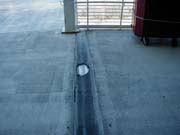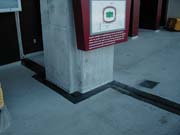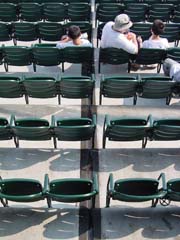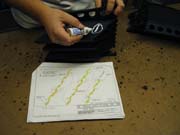
How can stadium owners ensure that their facility will be leak free? There are several steps that, if followed throughout the project, will ensure that the stadium remains dry and free of the need for expensive refurbishment.
Owner Responsibilities: Budget Appropriately
Less than 0.05% of a typical stadium construction budget is spent on expansion joints. However, a majority of post-tenancy problems with these structures relate to water ingress. Owners must be receptive to recommendations for superior technologies presented to them by designers and be prepared to allocate additional resources to the design contract to allow for the proper detailing of joints and their relationships to other structural elements. By spending slightly more of their construction budget on waterproofing, stadium owners and managers can expect - and indeed demand - trouble-free, dry, and lasting joint seals.Designer Responsibilities: Design for Joint Sealing Technologies from the Beginning
Even the best waterproofing system is going to fail if there are holes in the membrane. Structural expansion joints represent a planned hole in the waterproofing membrane. Therefore, it is wise to begin with consideration of how these major holes will be addressed and work the membrane materials out from there. Designing out expansion-joint problems begins with consideration of the following.Acknowledge the Need for Expansion JointsStructural materials have limitations. Extreme weather conditions can cause damage over time. Cracks that are the result of overstressed materials are nearly impossible to seal and can result in dangerous structural weaknesses. Properly designed expansion joints will prevent cracking, while carefully chosen sealant systems will withstand weather conditions and keep the facility dry.

Stay away from corners - Corners are a bad place for expansion joints. Do not cast, or use the joints between precast corner units, as the place for the structural expansion joints. Corners are impossible to set while creating a consistent expansion joint gap size. Furthermore, the angles created in a corner make awkward geometries for the attachment of sealant systems. Instead, cast the corners solid, or weld these precast connections and make them non-moving. Make the structural expansion joint in a straight line just off the corners.
Avoid planters - Never try to waterproof structural expansion joints inside planters. If the joint runs through areas where planters are designed, detail the planters with back-to-back walls, leaving the expansion joint sealable.
Keep away from obvious water sources - Keep scuppers away from joints, and don't slope drainage across joints. Instead, for example, locate joints at the top of a ramp. Do not expect a deck to drain down a ramp and over, under or through the joint.
Think about interiors - Joints cut completely through the whole structure. Therefore, think about interior layouts in relation to expansion joints. Considered early enough, it is even possible to hide some joints between back-to-back interior walls, thereby eliminating their aesthetic impact as well as the need to bridge them. Make sure interior subcontractors know where joints are and the effect the joints may have on location of mechanical or plumbing fixtures. Finally, select and specify all-metal, high-point-load expansion joints capable of handling small-wheeled catering, cleaning, and other traffic that typically destroys "rubber and rail" joint systems.

Choose split columns rather than single columns with slide-bearing pads. A single column structure results in hard-to-seal conditions around the column caps that create shear conditions for which most watertight joint systems are not designed. Split columns ensure that a system's sealing integrity can be maintained. Retrofit of failed joints around column caps in single-column construction is a specialty of joint manufacturer EMSEAL. However, the company's specialized "shear pocket" fabrication required for this type of retrofit comes at a premium. It is better, in new construction instances, to design out conditions requiring this expense.

There are four main facets related to sizing joints properly - expected movement, functional and installation temperature range, tolerance buildup, and movement capability. Architectural teams must also take the lead for sizing in joint design. Often, the structural team will make recommendations without considering a material and its movement capability and other effects on joint design. This can be avoided if the architectural team selects a technology and takes it to the structural team with the question, "What size joint do we need if we seal the joint with this specific technology?" The resulting joint size calculation can then take into account the movement capability of the product or technology type to be used.

Limit specifications to manufacturers that continually demonstrate a commitment to joint treatment, have sound technology, the ability to ensure and guarantee watertightness in plane and direction changes, and a commitment to quality. A trend in the specialty products industry is the tendency of suppliers to commoditize products, thereby removing much of the value essential to their proper performance. The ability and willingness of manufacturers to offer solutions and to fabricate watertight transitions in plane and direction, such as up and down treads and risers, remains a rare differentiator.
Features in purpose-designed joint systems, such as EMSEAL's MIGUTAN split-slab expansion joint, include integral heat-weldable, thermoplastic rubber flashing sheets for "sandwiching" into deck waterproofing materials on split-slab decks. This feature ensures total watertightness over occupied space below, while heavy-duty aluminum or steel side rails and stainless steel retaining capping strips allow long-term maintenance access to the sealing insert which in turn is designed to handle cyclical movements.

Develop isometric, line-sketch schematics to show all the joints throughout the stadium. Include all changes in plane, direction and intersection with other materials. This will put the design team on the same page, allowing all participants to identify and design out many problems before construction begins. Cross-reference the material selection for each joint in the schematic with a cross-section detail. In addition, show axonometric details of each transition in plane and direction, especially when illustrating transitions between different material technologies, e.g., between a concourse deck joint and a wall joint. Many manufacturers publish most of the axonometric details needed to detail and specify watertight transitions within the same product as well as between different technologies on their website. This makes detailing these conditions as simple as cutting and pasting.
Communicate Joint Locations to All Involved
Make sure to show expansion joints on all drawings, including structural, architectural, mechanical and landscape. In the specifications, include a specific reference for responsibility of all trades to appropriate treatment of their work at expansion joints.
Write Project-Specific Specifications
Stadiums are not the place to use a "cookie-cutter" approach to expansion joint design. The specifications for each job must match the specific performance demands of each venue. Research available technologies, implement them into the design and write specifications that reflect the choice. Make sure to stick with the plan throughout the project to ensure technological continuity and continuity of seal.
Have Courage
Joint systems represent a small percentage of stadium construction jobs. Having engaged in the aforementioned expansion joint design-emphasis process, designers should have the courage to defend proprietary specifications of superior joint systems, and hold to them even under pressure for substitutions of cheaper, less effective alternatives.

Contract Execution - General Contractor, Owner Responsibilities
Limit Work to Carefully Selected Contractors
Limiting work to a select group of contractors, often those recommended by the expansion joint system manufacturer, can be a huge factor in ensuring watertight joint seals. These contractors have been properly trained to install the chosen systems and can address substrate conditions that help ensure watertightness. Because they work closely with manufacturers, these contractors are not likely to underbid the job, keeping change-order cost increases to a minimum, and are likely to be versed in-and willing to remain committed to-a communication process involving the designer, owner representative, manufacturer, and general contractor.
Communicate Clearly and Often
Hold a pre-construction meeting with all parties involved in the treatment of work at and around expansion joints. This meeting should take place prior to pouring concrete that will define the expansion joints. Make sure all superintendents and forepersons with responsibility for casting activities attend the meeting to review issues such as the following.
- Forming joint-gaps in relation to temperature changes
- Ensuring solid-form construction to prevent collapsed and misaligned joint forming
- Proper consolidation and thorough vibration of slab edges and blockouts
- Zero tolerance on blockout formation
- Finesse concrete work for final blockout preparation
- Location, elevation and configuration of joint curbs
- Execution of concrete work to handle transitions to vertical plane
- Protection of joints and traffic routing until decks are opened to normal use
Emphasize Expansion Joints during All Construction Phases
Continue to place expansion joints on meeting agendas throughout the construction process. Many subcontractors, including electrical, HVAC, masonry, flooring, façade panel, waterproofing and caulking, work in close proximity to expansion joint locations and they must be aware their work cannot impede structural movement that will occur at expansion joints or compromise the achievement of watertightness at expansion joints in any way. As the construction progresses, the general contractor must emphasize expansion joints during each stage. Expansion joints must be considered a critical path item, rather than an added piece at the end of the project. Failure to emphasize expansion joints during construction is a significant contributor to delays, cost overruns and the reworking that characterizes preparation of joints to receive the expansion joint systems.
Conclusion
Common complaints stadium owners and managers have endured as a result of leaking expansion joints include sky boxes that won't heat or cool; destroyed flat-screen TVs and garbage bags over seats in high-dollar corporate boxes; infuriated, dripped on, highly compensated athletes; lost concession-vendor revenue; and icy slip hazards. Furthermore, most retrofit expansion joint contracts far exceed the cost of doing it right the first time. Stadium construction is a complex process. Nevertheless, with notable new construction successes, such as Phillies Ballpark and Keyspan Park, and numerous retrofit successes, including FedEx Field, Fenway Park, and American Airlines Arena, EMSEAL, working with like-minded owners, designers, and contractors, has demonstrated that a new paradigm for expansion joint treatment is not only possible, but also practical.About the Company
EMSEAL Joint Systems Ltd. is the leading manufacturer of premium sealants and expansion joint systems for the commercial construction industry, as well as for numerous gasketing applications in specialty market applications. The company has operated out of locations in the Greater Toronto Area in Canada and the Northeast United States for over 25 years.For more information, call (800) 526-8365 or visit www.emseal.com.